plectros III [1971-I], for piano and synthesized sounds
plectrum: a small piece of wood, metal or ivory, used for plucking strings on music instruments; an anatomical part resembling a plectrum in shape (from the Greek “pléktron”).
Started in 1962, the plectros series offers a complex vision of piano performance practices in my piano works. plectros I [1962‑II], for one piano with two pianists, utilized graphic notation, theatrical gestures and sounds obtained by performing directly on the strings of the instrument, using fingers, thimbles, car keys and mallets. The result is still electroacoustic sounding, and quite intriguing.
plectros II [1966‑I], for piano and electronic sounds, was written more in a “virtuoso” style, influenced by the prevailing sounds and complex rhythms of the New York electroacoustic scene during the 60s. My idea was to create a tape part that sounded like inside the piano sonorities, but all done electronically. At the same time and via special performance practices and innovative notation, the pianist was to elicit electronic sounding sonorities just by playing on the keyboard — using careful control of dynamics and attacks — and also using some harmonics and muted sounds.
Continuing my interest in writing for the piano, but with a twist, I wrote plectros IV [1974‑I], for two pianists of opposite sex, miscellaneous percussion and tape. A theatre piece, this work multiplies the pianos during a fragment, using a quotation from Schumann’s Fantasy, played live by the pianists, echoed and reverberated by live electronics, with similar fragments heard on a quadraphonic tape emanating from the loudspeakers. The piece requires the use of regular and contact microphones plus a tape delay system. Since 1968 I have been using the expression “electronic extensions” to describe these audio effects, what today is referred to as “digital signal processing”, or DSP.
The last in the plectros series is plectros V [2001‑I], for prepared piano and percussion ensemble.
Through the years many distinguished pianists have performed one or more in the plectros series: Gerardo Gandini and Armando Krieger (plectros I was written for them), Carla Hübner (dedicatee of plectros II), Stephen Clarke, Bruce Mather and Pierrette Lepage (for whom plectros IV was written), Carles Santos, Robert F. Jones, James Sykes and others.
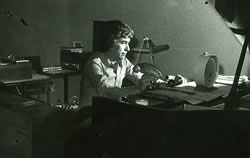
plectros III uses mostly long, sustained piano sounds, created via special attacks and the use of superball mallets 1[1. In reference to “super-ball mallets”, which I started using in New York around 1967, here is an extract of an exchange of information between me and Tom Johnson, related to his article “Old Times and New Music” in Musicworks 89 (Summer 2004): “There was room for ‘inventing’ unusual instruments or exploring new performances practices in our group [the composers/performers group, in New York]. I was — and still am — a born experimentalist, so from prepared pianos to new instruments, all was experimented with… It comes to mind the use of ping-pong balls [in Juegos [Games], by Gustavo Becerra, 1967, at the Interamerican Music Festival, Washington, DC], and the first use of ‘super-balls’ as a new percussive mallet [my own ekphonesis III [1969], plectros III [1971], and eidesis III [1971].”] and synthesized sounds — both on tape and produced in real time.
The general idea of the piece is to match, precede and follow the tape sounds in an improvisatory manner, playing directly on the strings of the piano, on the wooden or metal parts of it, the floor or the bench, all done using superball mallets.
The tape part was realized at the McGill University Electronic Music Studio and at the SHELAN Studio in Montréal. Many of the low frequency droning tones were created with the Hugh Le Caine Tone Mixture Generator. 2[2. Hugh Le Caine (1914–1977): Canadian inventor of electronic music instruments. His machines populated the principal electronic music studios in Canada — Toronto, Montréal, Kingston. His Tone Mixture Generator (1965) consisted of 13 tunable oscillators. Producing interesting tone clusters, it was also possible to achieve massive glissandi over a two-octave span thanks to a rotating wheel acting as voltage control.] Some sections were done by having two identical tape loops running simultaneously, but at slightly different tape speeds: the droning sounds began to cause small textural frictions in relation to each other, an aural phenomena that I found to be of interest at the time.
Originally the piece consisted of a few paragraphs — just written indications of what sounds to produce by rubbing this or the another part of the lid, where to place certain objects (superball mallets, ashtray, car keys, etc.), as well as suggestions concerning other performance practices (eliciting harmonics, snapping low strings, playing in near darkness, etc.).
In this fashion plectros III was premiered in Pasco, Washington (1971), during a Music Dealers convention. The synthesized and sequenced sounds were done with a portable Synthi AKS, a device developed by Peter Zinovieff in London, England.
Eventually, since my publishers Boosey & Hawkes (New York), were having problems registering my improvised works with the Library of Congress, a written, visual score was requested. This is the surviving version, which after all was not published by Boosey & Hawkes, but was published by SHELAN, in Montréal.
The first published version of the piece suggested the use of a portable multi-timbral, polyphonic digital synthesizer and sequencer.
By 1974, responding to rapid technological changes, I decided to slightly modify the tape part to include some of the synthesized sounds in it. Therefore, there is no need to include a portable synth as part of the gear controlled by the pianist.
This composition is usually performed in total darkness, using only two small flashlights placed inside the open piano, to help see the stopwatch (if used), and to cast eerie reflections.
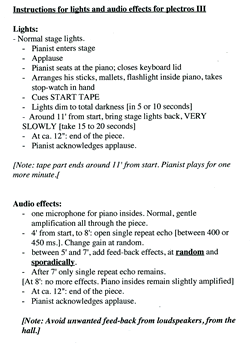
Other pianists have performed this piece, but basically I wrote plectros III as a vehicle for my own interpretation. Hence, some adjustments have been made through the years, like modifications to the stage lights (turn off lights in the hall after the pianist is in position to play; turn off stage lights; bring stage lights back, slowly, during the last minute of the piece); or requesting audio effects like slow or fast single-repeat echo, later on adding “feedback” effect (Fig. 1).
My solo recital at Roulette on 8 March 1983, in downtown New York City, elicited the following comments by Allen Hughes, the music critic from the New York Times:
Imagine the mysterious sounds of a summer night in the country when frogs, insects and night birds are particularly vocal, and you are on the way to imagining the sounds of Alcides Lanza's ''Plectros III,'' a work for piano and tape music performed by the composer at Roulette on Tuesday night. [He] did not play the piano conventionally in ''Plectros III.'' Instead, he stroked and struck the strings and case of the instrument with mallets and in other ways to produce a remarkable variety of sonorities… 3[3. Allen Hughes, “Concert: Alcides Lanza” in The New York Times, 11 March 1983. Available on the NY Times website [Last accessed 10 April 2011]]
Other performances of plectros III include: during my “infamous” recital titled alcides lanza: 77'29" (Redpath Hall, Montréal, 18 January 1974); during my Piano Marathon I (Pollack Hall, Montréal, 13 October 1987). Several performances of the piece took place at the Oscar Peterson Concert Hall, Concordia University, Montréal, the most recent one as part of EuCuE XXVIII, on 11 February 2010, a performance which was the premiere of the quadraphonic version.
Internationally plectros III has also been presented in Spain, Germany, Sweden, Brazil and Argentina.
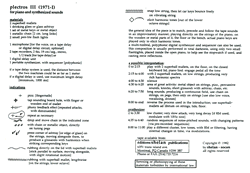
On Performance Practices and Notation
The composer has created a number of symbols to define performance practices like pizzicati with fingernails, tapping inside the soundboard holes, doing a “phony feed-back effect”, creating a glissandi with harmonics by pressing the corner of a plastic ashtray (or a glass) on the strings, while striking corresponding keys, etc. (Fig. 2)
The score is written in graphic notation; consequently its three pages are easily memorized.
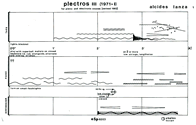
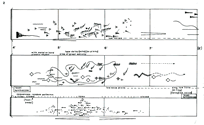
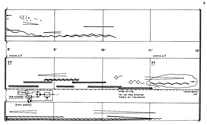
The electronic manipulations are to be done by a technician, mostly the normal amplification, the addition of tape delay or digital delay, controlling the microphone for the pianist voice (used from page 2 to the end, like a “low drone”). [Fig. 3b]
See the instructions “snap strings” and “let car key bounce freely on vibrations”, a special sonority that has become a kind of “alcides lanza sonic signature” (Fig. 3c).
The pianist can follow time by glancing at a stopwatch, with a small penlight shining on it. This small amount of luminosity is sufficient — once the eyes adapt to the situation — for the pianist to be able to find his way, find objects or mallets, etc. The penlight also casts eerie reflections on the metallic parts of the inside of the piano.
Conclusion
It is possible that plectros III is actually a “theatre piece” but… there is almost nothing to see. However — and the review quoted above is an indication of this — the audience also adjusts their eyes to the dim light situation, and under such conditions, the audience sees eerie reflections on shiny or metallic objects like the instrument itself, the microphone stands, etc., the visual interplay with other permanent small lights in the hall like the “EXIT” signs, and they may imagine seeing other things which are not actually there at all. In my understanding psychology becomes part of the game when one listens to music in the dark or with closed eyes: it is only human that one will hear in a different manner. The eerie reflections of faint light combined with undulating, trembling long sonorities emanating from the unknown — perhaps from the floor, the underside of the piano, or by rubbing lower strings, all of the above getting the listeners to hear via their skins, ears and the brain, imagining sonic objects which actually may not be there at all. In short, it may bring the listener into an out-of-worldly sonic experience.
Recordings
plectros I [1962-II], for one or two pianos
Música Argentina Contemporánea, Vol. 1. Armando Krieger and Antonio Tauriello, pianos. Ten Records (Buenos Aires, Argentina), 1968.
plectros II [1966-I], for piano and electronic sounds
Musicworks 82. Stephen Clarke, piano. Musicworks [MW82], 2002.
Música Argentina Contemporánea, Vol. 1. Carla Hübner, piano. Ten Records (Buenos Aires, Argentina), 1968. Re-released on the CD compilation Creelpolation 1, Creel Pone Records [56/7/8], 2006.
SONUS.ca, the CEC’s Electroacoustic Jukebox. alcides lanza, piano. https://sonus.ca/app/ui/more.php?MediaID=750
McGill Electronic Music Studio Archive. alcides lanza, piano. Recorded at Clara Lichtenstein Recital Hall, McGill University (Montréal), January 1988. Recording engineer: Peter Cook. http://www.music.library.mcgill.ca/audio/memsa/memsadatlanple2.mp3
plectros III [1971-I], for piano and electronic sounds
Musicworks 83. alcides lanza, piano. Musicworks [MW83], 2002. Also available onlineon SONUS.ca, the CEC’s Electroacoustic Jukebox. https://sonus.ca/app/ui/more.php?MediaID=751
plectros IV [1975], for two pianists of opposite sex, miscellaneous percussion and tape
Bruce Mather and Pierrette Lepage, pianos. Included in the Latin American Electroacoustic Music Collection, curated by Ricardo Dal Farra. http://www.fondation-langlois.org/html/e/oeu.php?NumEnregOeu=o00001981
Social top